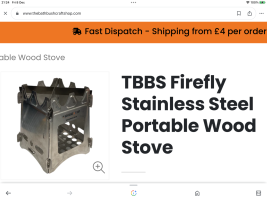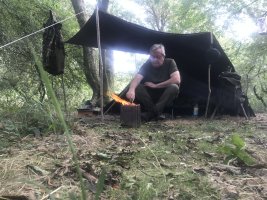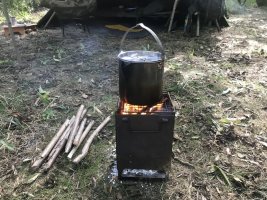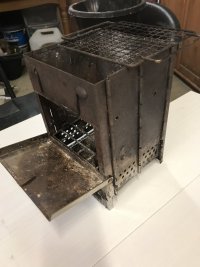Wood stove
- Thread starter MikeLA
- Start date
You are using an out of date browser. It may not display this or other websites correctly.
You should upgrade or use an alternative browser.
You should upgrade or use an alternative browser.
I've just got switched from a cheap stove like that because it is a bit of a pain in the backside to put together, so could see it being a problem if freezing cold/dark/wet. Also the metal will last for a few uses I'm sure, but can imagine after a while it'll deform. Pictures posted by people online seem to back up this assumption.
I switched to a Bushbox LF which is hinged, so super easy to deploy, and made of much more robust metal.
Depends what your use case is really, but if it's your only stove and you might be relying on it in the cold/dark/wet, then personally I think it's worth spending a bit more to get something that'll not let you down.
I switched to a Bushbox LF which is hinged, so super easy to deploy, and made of much more robust metal.
Depends what your use case is really, but if it's your only stove and you might be relying on it in the cold/dark/wet, then personally I think it's worth spending a bit more to get something that'll not let you down.
I'vebeen using one of these for a couple of years now. It's a bit heavier than the one you looked at, but sturdy and easy to assemble, even in the cold. I like it a lot.
Attachments
I was very interested in wood burners and had a little look two years back.
My feeling is really that “might makes right”. You need a fairly large stove to be:
A wood burning stove NEEDS to be specialised for that. A ‘stove’ for an alcohol burner is ALWAYS going to be too small. Burning wood will always need more air.
If the metal of the stove was cold rolled to straighten it, once you heat it you will relax cold working and the panels will bow. The panels will bow because the sheet metal was rolled to final thickness or rolled to straighten it. My stove is ‘perfectly symmetrical’ so I turned every second panel inside out to form a “W” pattern so while every panel has a single curve… it sort of packs down fairly flat… But like 20 mm rather than the 5 mm we might naively have hoped for.
Real world, if you’ve got a really really sloppy fit like 6 mm panel gap!!! Use the stove on rough ground and suddenly you won’t care it’s just extra ventilation and everything just works.
Some designs stood out to me, I’ve ranked them by surface area. I wanted to avoid anything too tall (16 cm??) because I was thinking about a windscreen and my billy. Plus wanted to avoid "too heavy".
My rule of thumb is about 5.47 watts per cm^2 based practical experiments*. Your mileage may vary.
EDIT: * You will need an axe (or a tough knife) to split the wood. The wood needs to be seasoned / very dry. You will need to use the right wood (something that will split well). A black pot will adsorb heat better. A larger area like a wide base kettle is going to work better than a slender water bottle.
Last night in very reasonable conditions I managed only 1/3 of what my stove was capable of, about 375 watts: a new 1 litre canteen took about 16 mins for a roaring boil. I had full stove of burning Birch wood with big flames shooting out the top. So take my rule of thumb with a thimble of salt. "Might makes right" because after 10 mins, you might be added another handful of real (slightly damp) pencil to thumb sized twigs and oh you've lost 3 mins.
Wood gasifiers should be around 1.25 times more powerful for the same area... When they work. I call my small gasifiers: a toy for survival training. Tip: (my) Wood gasifiers coat pans with a pretty tough layer of glossy black wood tar. So if you want a black pot you'll get a glossy black finish in around 30 seconds.
The rule of thumb, for physics: Boiling 1 litre of water in 6 mins (360 seconds) is 1 kW. By timing a boil test you can get an indication of power, And marvel at the 3kW electric kettle. If you need to melt ice/snow you need twice the energy.
Littlbug Senior Stove. Big enough to do the job, and light enough to carry. (Est 1700 watts. 540 grams)
Nimblewill Nomad Little Dandy Stove / Petromax hobo stove. This was a free pattern, I had hoped to have built one. It will pack flat. (Est 1300 watts… I might have designed mine to match a rectangular billy… or a piece of sheet metal.) 23 by 10.5 by 11.5 cm, 585 grams.
My own ‘design’ using 6 inch stainless steel drain covers. (Est 1300 watts. 450 grams and under £12.) I’ve rambled elsewhere if you want pictures and a story to read: https://www.slingshotforum.com/threads/diy-bio-mass-stove.39338/#post-1599088
No. 10 can hobo stove. (Est 1000 watts. 200 grams.)
Lixada, squarey hole, titanium. (290 grams) £24 direct or £34 … (Emberlit clone, only bigger). It was the biggest Titanium stove Lixada made in the series. There was a larger stove in stainless. This will also pack flat. (Est. 700 watts. 290 grams… Titanium.)
11.5 cm at the top, 15.3 cm at the bottom, and 18 cm tall. Sizes from retailer.
Ikea’s ORDNING Cutlery stand. Small and light weight. (Est. 600 watts. 150 grams.)
This is the standard I measure other stoves against.
I copied the pictures from website and used the measure tool in (the GNU image manipulation program): So my rough estimate is the top is about 9.5-9.7 cm... so ~500 watts.
You might find the lower power more suitable or even essential for proper cooking, rather than thrashing a container to boil water. But might makes right: I wouldn't want to buy, build or carry a stove I wasn't confident in.
I can burn Ash (Fraxinus Excelsior) twigs like slow burning fuses to keep an ember alive for hours and hours. But I can't turn a marginal wood stove into a reliable tool to boil water. Read my boil test with the drain cover stove, I couldn't keep hitting my personal best... But I was able to get outside day, night, wind and rain and practice.
Plus I've got (wax fueled) buddy burners (200 grams, fully loaded) and alcohol fueled penny stoves (Which weigh next to nothing, so 100 grams for fuel?) if I want another tool to practice with.
My feeling is really that “might makes right”. You need a fairly large stove to be:
- Big enough in the first place for a fire lay, the biggest problem is getting enough air to build enough heat. I respectful believe most people get this wrong.
- Resilient when using natural (damp) wood, take thicker material (up to 3 inch diameter). You need more volume (bigger stove) and more air to burn enough damp wood for a reasonable output. The variable of getting the air right is a bit problem... Plus ideally with a stove you should have some means to limit the air to slow down combustion and reduce fuel usage.
- Independent and not need continuous feeding or preparing fine sticks. This means you can get on with cooking.
A wood burning stove NEEDS to be specialised for that. A ‘stove’ for an alcohol burner is ALWAYS going to be too small. Burning wood will always need more air.
If the metal of the stove was cold rolled to straighten it, once you heat it you will relax cold working and the panels will bow. The panels will bow because the sheet metal was rolled to final thickness or rolled to straighten it. My stove is ‘perfectly symmetrical’ so I turned every second panel inside out to form a “W” pattern so while every panel has a single curve… it sort of packs down fairly flat… But like 20 mm rather than the 5 mm we might naively have hoped for.
Real world, if you’ve got a really really sloppy fit like 6 mm panel gap!!! Use the stove on rough ground and suddenly you won’t care it’s just extra ventilation and everything just works.
Some designs stood out to me, I’ve ranked them by surface area. I wanted to avoid anything too tall (16 cm??) because I was thinking about a windscreen and my billy. Plus wanted to avoid "too heavy".
My rule of thumb is about 5.47 watts per cm^2 based practical experiments*. Your mileage may vary.
EDIT: * You will need an axe (or a tough knife) to split the wood. The wood needs to be seasoned / very dry. You will need to use the right wood (something that will split well). A black pot will adsorb heat better. A larger area like a wide base kettle is going to work better than a slender water bottle.
Last night in very reasonable conditions I managed only 1/3 of what my stove was capable of, about 375 watts: a new 1 litre canteen took about 16 mins for a roaring boil. I had full stove of burning Birch wood with big flames shooting out the top. So take my rule of thumb with a thimble of salt. "Might makes right" because after 10 mins, you might be added another handful of real (slightly damp) pencil to thumb sized twigs and oh you've lost 3 mins.
Wood gasifiers should be around 1.25 times more powerful for the same area... When they work. I call my small gasifiers: a toy for survival training. Tip: (my) Wood gasifiers coat pans with a pretty tough layer of glossy black wood tar. So if you want a black pot you'll get a glossy black finish in around 30 seconds.
The rule of thumb, for physics: Boiling 1 litre of water in 6 mins (360 seconds) is 1 kW. By timing a boil test you can get an indication of power, And marvel at the 3kW electric kettle. If you need to melt ice/snow you need twice the energy.
Littlbug Senior Stove. Big enough to do the job, and light enough to carry. (Est 1700 watts. 540 grams)
Nimblewill Nomad Little Dandy Stove / Petromax hobo stove. This was a free pattern, I had hoped to have built one. It will pack flat. (Est 1300 watts… I might have designed mine to match a rectangular billy… or a piece of sheet metal.) 23 by 10.5 by 11.5 cm, 585 grams.
My own ‘design’ using 6 inch stainless steel drain covers. (Est 1300 watts. 450 grams and under £12.) I’ve rambled elsewhere if you want pictures and a story to read: https://www.slingshotforum.com/threads/diy-bio-mass-stove.39338/#post-1599088
No. 10 can hobo stove. (Est 1000 watts. 200 grams.)
Lixada, squarey hole, titanium. (290 grams) £24 direct or £34 … (Emberlit clone, only bigger). It was the biggest Titanium stove Lixada made in the series. There was a larger stove in stainless. This will also pack flat. (Est. 700 watts. 290 grams… Titanium.)
11.5 cm at the top, 15.3 cm at the bottom, and 18 cm tall. Sizes from retailer.
Ikea’s ORDNING Cutlery stand. Small and light weight. (Est. 600 watts. 150 grams.)
This is the standard I measure other stoves against.
I copied the pictures from website and used the measure tool in (the GNU image manipulation program): So my rough estimate is the top is about 9.5-9.7 cm... so ~500 watts.
You might find the lower power more suitable or even essential for proper cooking, rather than thrashing a container to boil water. But might makes right: I wouldn't want to buy, build or carry a stove I wasn't confident in.
I can burn Ash (Fraxinus Excelsior) twigs like slow burning fuses to keep an ember alive for hours and hours. But I can't turn a marginal wood stove into a reliable tool to boil water. Read my boil test with the drain cover stove, I couldn't keep hitting my personal best... But I was able to get outside day, night, wind and rain and practice.
Plus I've got (wax fueled) buddy burners (200 grams, fully loaded) and alcohol fueled penny stoves (Which weigh next to nothing, so 100 grams for fuel?) if I want another tool to practice with.
Last edited:
Not flatpack or light (1lb 13oz with ash pan) but for day trips, the larger sized (8 inch diameter) wood gasifier stove also throws out over twice the heat of it's smaller brethern.

 www.aliexpress.com
www.aliexpress.com

Picnic Outdoor Stove Portable Compact Versatile Fuel Options Anti-rust Anti-corrosion Efficient Heating Firewood Stove - AliExpress 18
Smarter Shopping, Better Living! Aliexpress.com
I know that I sound like a KK rep but I have no association with the company.
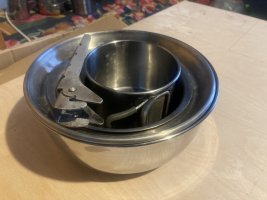
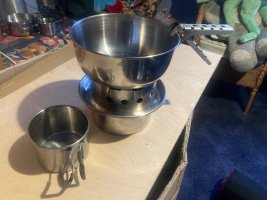
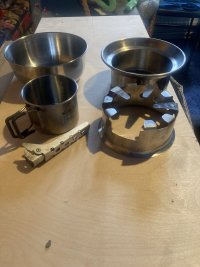
This setup weighs 700gms (1lb 10oz) including dog bowl, mug and gripper.
What’s more there is still space for a small first aid kit and a pair of socks in the set up. Just KK fire base and Hobo weigh 500gm. This is the larger set up for the I litre and 1.5 litre kettles.
It’s all new because I’m about to do a review on another site - OK so it will be more like a eulogy!!!.
All KK publicity seems to be done with new kit - even packing it away after use.
This is what a much loved Kelly Hobo looks like.
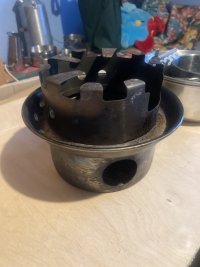
Little sister weighs just 225 gms.
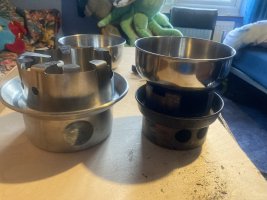
I carry a Trangia burner with both of them but it’s better in the little stove. In a pinch I’ve just flooded the big fire base with meths dropped in a paper handkerchief to get things going (in a heavy frost) and stood back while it boiled 1.5 litres.
Edited to add:
Stand the fire base on three stones and you don’t leave a fire site behind. The ground is scorched but a kick and a scuff and it would take an expert tracker or a dog to know you’d been there.
Edited again to further add:
If you are a mini alcohol stove fan then the Hobo works well on its own. You don’t even need the fire base.



This setup weighs 700gms (1lb 10oz) including dog bowl, mug and gripper.
What’s more there is still space for a small first aid kit and a pair of socks in the set up. Just KK fire base and Hobo weigh 500gm. This is the larger set up for the I litre and 1.5 litre kettles.
It’s all new because I’m about to do a review on another site - OK so it will be more like a eulogy!!!.
All KK publicity seems to be done with new kit - even packing it away after use.
This is what a much loved Kelly Hobo looks like.

Little sister weighs just 225 gms.

I carry a Trangia burner with both of them but it’s better in the little stove. In a pinch I’ve just flooded the big fire base with meths dropped in a paper handkerchief to get things going (in a heavy frost) and stood back while it boiled 1.5 litres.
Edited to add:
Stand the fire base on three stones and you don’t leave a fire site behind. The ground is scorched but a kick and a scuff and it would take an expert tracker or a dog to know you’d been there.
Edited again to further add:
If you are a mini alcohol stove fan then the Hobo works well on its own. You don’t even need the fire base.
Last edited:
This is true, however, the set up for the M40 (SS) and M44 (Al) alcohol stoves work perfectly well with wood if turned upside down.A ‘stove’ for an alcohol burner is ALWAYS going to be too small. Burning wood will always need more air.
You will lose the paint and soften the aluminium but mine is still alive and cooking.
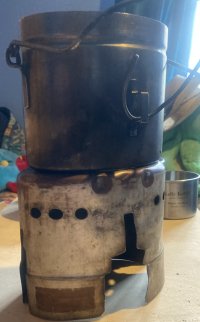
pee ess. The bale handle arrangement doesn’t work when you use wood. Everything gets very hot. A gripper solves that one.
I just received my Firebox and I'm looking forward to testing it out, Of course the day I get it we are under a Hurricane so I will have to wait a couple of days.




I have this same stove and it's a nice set up, I have the medium size and the larger size and used only a couple of times. Can't go wrong with this stove.I'vebeen using one of these for a couple of years now. It's a bit heavier than the one you looked at, but sturdy and easy to assemble, even in the cold. I like it a lot.
I find this is a good option, combined with a zebra pot.Not flatpack or light (1lb 13oz with ash pan) but for day trips, the larger sized (8 inch diameter) wood gasifier stove also throws out over twice the heat of it's smaller brethern.

Picnic Outdoor Stove Portable Compact Versatile Fuel Options Anti-rust Anti-corrosion Efficient Heating Firewood Stove - AliExpress 18
Smarter Shopping, Better Living! Aliexpress.comwww.aliexpress.com
The 14cm short pot will neatly contain one of these wood gasifies so it’s pretty compact. The stove can easily use esbit type blocks as well.
Not the lightest kit possible, but self contained and pretty neat when packed.
One thing have found is you need to have the fire going well before putting the pot on or it risks going out, could be an airflow issue, not sure. It all generally cools down quickly for repacking on the move.
Similar threads
- Replies
- 15
- Views
- 930

